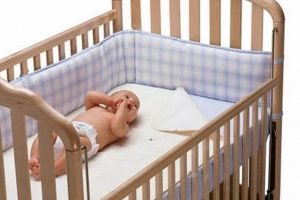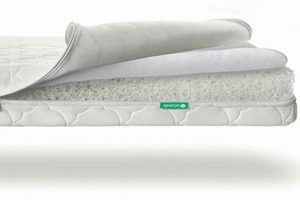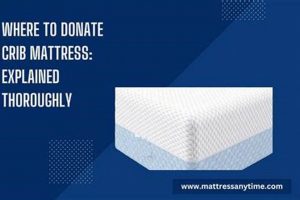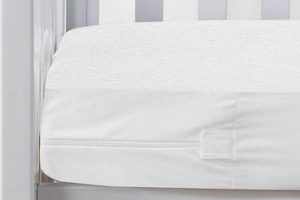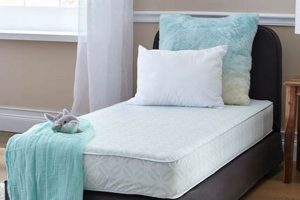A dual-sided infant sleep surface offers differing firmness levels intended to accommodate the developmental stages of a child from infancy to toddlerhood. One side provides a firmer surface recommended for newborns, while the opposite side offers a slightly softer composition designed for older babies and toddlers. The product under consideration is manufactured by Sealy, a well-known brand in the bedding industry, and designed specifically for use in a standard-sized crib.
The primary advantage of such a product lies in its adaptability to a growing child’s needs, potentially extending its usability and offering cost-effectiveness over purchasing separate mattresses. Historically, crib mattresses were often single-sided and required replacement as the child grew. The introduction of dual-stage models represents an evolution in design aimed at providing appropriate support and comfort throughout early childhood.
The following sections will delve into key considerations when evaluating such products, including safety standards, material composition, construction techniques, and recommendations for optimal use and maintenance.
Key Considerations for a Dual-Sided Crib Mattress
This section provides essential guidance when selecting and utilizing a dual-sided crib mattress, with an emphasis on safety, longevity, and proper care.
Tip 1: Verify Safety Certifications: Confirm the mattress meets or exceeds current safety standards, such as those set by the ASTM International and the Consumer Product Safety Commission (CPSC). Look for certifications clearly displayed on the product packaging.
Tip 2: Assess Firmness: The infant side should be sufficiently firm to prevent indentation and reduce the risk of suffocation. A simple test involves pressing down on the surface; minimal give is desirable.
Tip 3: Evaluate Material Composition: Consider the materials used in construction. Options include foam, innerspring, and plant-based alternatives. Ensure materials are non-toxic and free from harmful chemicals like phthalates and lead.
Tip 4: Ensure Proper Fit: The mattress must fit snugly within the crib frame, with no gaps larger than two fingers’ width between the mattress and the crib sides. This prevents entrapment hazards.
Tip 5: Rotate and Flip Regularly: Rotate the mattress every few months to promote even wear. Once the child reaches toddler age, flip the mattress to the softer, toddler-designated side.
Tip 6: Utilize a Waterproof Mattress Protector: Protect the mattress from spills and accidents with a waterproof, breathable mattress protector. This helps maintain hygiene and extends the life of the mattress.
Tip 7: Clean Spills Immediately: In the event of spills, clean the mattress promptly with a mild detergent and water. Allow the mattress to air dry completely before replacing the bedding.
Prioritizing safety, selecting appropriate materials, and maintaining proper hygiene are crucial for maximizing the benefits of a dual-sided crib mattress and ensuring a safe sleep environment for the child.
The next section will address potential issues and troubleshooting.
1. Firmness
Firmness on the infant side of a Sealy 2-Stage Crib Mattress is a critical safety parameter directly impacting a newborn’s well-being. It is a core design feature intended to mitigate risks associated with infant sleep environments and is governed by established safety standards.
- Suffocation Risk Mitigation
The primary function of a firm infant sleep surface is to reduce the risk of suffocation. A softer surface can conform to a baby’s face, potentially obstructing airways. A Sealy 2-Stage Crib Mattress, when used correctly on the infant side, provides a rigid plane that minimizes this possibility. Independent testing agencies and consumer safety organizations prioritize firmness evaluations in their assessments of crib mattresses.
- SIDS Prevention
While not a direct causal factor, a firmer sleep surface is recommended as part of safe sleep practices aimed at reducing the risk of Sudden Infant Death Syndrome (SIDS). Organizations such as the American Academy of Pediatrics (AAP) advise against soft bedding and emphasize the importance of a firm mattress. The Sealy 2-Stage Crib Mattress is engineered to align with these recommendations on its designated infant side.
- Developmental Support
A sufficiently firm surface provides appropriate support for a newborn’s developing musculoskeletal system. It allows for proper spinal alignment and reduces the risk of uneven pressure distribution. The Sealy 2-Stage Crib Mattress’s firmness is carefully calibrated to provide the necessary support without compromising comfort, promoting healthy physical development during crucial early months.
- Material Density and Construction
The firmness of the infant side of a Sealy 2-Stage Crib Mattress is achieved through specific material choices and construction techniques. Denser foam or a higher coil count in innerspring models contributes to the required rigidity. These design elements are integral to meeting safety regulations and ensuring the mattress performs as intended throughout its lifespan. Consistent material integrity is vital for maintaining the safety and support characteristics.
The stringent firmness requirements of the infant side of the Sealy 2-Stage Crib Mattress are not merely design considerations but fundamental safety features. Compliance with established safety standards, coupled with proper usage, is essential for creating a secure sleep environment for infants. Deviation from these standards could potentially compromise infant safety.
2. Support
The “Support: Toddler side” aspect of a Sealy 2-Stage Crib Mattress is crucial for the developing musculoskeletal system of a growing child. It represents a calibrated balance between firmness and cushioning, diverging from the stricter firmness requirements of the infant side. Proper support at this stage contributes to spinal alignment and overall comfort.
- Spinal Alignment and Posture
The toddler side of the mattress is designed to provide appropriate support for the spine as the child transitions to more active movements and prolonged periods of standing and walking. Sufficient support prevents spinal misalignment and promotes healthy posture development. Real-world examples include observing a child’s gait and posture; inadequate support can contribute to poor biomechanics and discomfort. The Sealy 2-Stage Crib Mattress aims to mitigate these issues through its engineered toddler-side construction.
- Pressure Distribution and Comfort
As toddlers gain weight and develop muscle mass, the distribution of pressure on the mattress changes. The toddler side incorporates materials and construction techniques designed to evenly distribute this pressure, minimizing localized stress points. This enhanced comfort contributes to improved sleep quality. Consider the impact on sleep disturbances; uneven pressure distribution can lead to restlessness and interrupted sleep patterns. The Sealy 2-Stage Crib Mattress is intended to address these concerns through optimized pressure distribution characteristics.
- Material Composition and Density
The materials used in the toddler side often differ from those on the infant side, typically incorporating a slightly less dense foam or a different coil configuration in innerspring models. This modification allows for a greater degree of cushioning while maintaining adequate support. Analyzing material specifications reveals the rationale behind this design choice; a less dense material conforms more readily to the child’s body contours. The Sealy 2-Stage Crib Mattress utilizes these material science principles to provide a tailored support experience.
- Durability and Longevity
The toddler side must withstand increased weight and activity levels compared to the infant side. Durable materials and robust construction are essential for maintaining its support characteristics over time. Observing mattress performance over extended use reveals the importance of this factor; premature sagging or compression compromises the mattress’s effectiveness. The Sealy 2-Stage Crib Mattress is designed to endure the demands of toddler use, ensuring continued support and comfort throughout this developmental stage.
The design considerations for the “Support: Toddler side” of a Sealy 2-Stage Crib Mattress reflect the evolving needs of a growing child. From spinal alignment to pressure distribution, the features of the toddler side are deliberately engineered to provide optimal comfort and support, contributing to healthy development and restful sleep. The specifications of this side are distinct from those of the infant side, showcasing the thoughtful design inherent in a dual-stage mattress.
3. Safety certifications
Safety certifications serve as independent verification of a Sealy 2-Stage Crib Mattress’s compliance with established safety standards, offering assurance to consumers regarding the product’s construction, materials, and overall safety profile. These certifications are not mere marketing claims but represent rigorous testing and evaluation processes.
- CPSC Compliance
The Consumer Product Safety Commission (CPSC) sets mandatory safety standards for crib mattresses to protect infants from hazards such as suffocation, entrapment, and injuries. A Sealy 2-Stage Crib Mattress bearing the CPSC compliance mark indicates it meets these federal regulations. Examples include impact testing, flammability testing, and ensuring proper dimensions to prevent gaps between the mattress and crib frame. Non-compliance can result in product recalls and legal liabilities for the manufacturer.
- ASTM International Standards
ASTM International develops voluntary consensus standards that are often adopted or referenced in regulations. ASTM F2933 is the standard consumer safety specification for crib mattresses, covering aspects such as firmness, static load, and mattress thickness. Certification to ASTM F2933 demonstrates a commitment to exceeding minimum regulatory requirements. For instance, the standard specifies a firmness level on the infant side to reduce suffocation risk. Failure to meet these standards may result in the denial of certification.
- CertiPUR-US Certification
CertiPUR-US certification applies to the foam components used in some Sealy 2-Stage Crib Mattresses. This certification ensures that the foam has been tested for harmful chemicals, including phthalates, heavy metals, formaldehyde, and volatile organic compounds (VOCs). It verifies that the foam meets specific standards for content, emissions, and durability. Examples of benefits include reduced indoor air pollution and minimized exposure to potentially harmful substances. Lack of this certification may raise concerns about the chemical composition of the mattress.
- Greenguard Gold Certification
Greenguard Gold certification focuses on chemical emissions and indoor air quality. A Sealy 2-Stage Crib Mattress with this certification has been tested and verified to have low chemical emissions, meeting stringent standards for over 360 VOCs and total chemical emissions. This is particularly important for infants who spend a significant amount of time sleeping in close proximity to the mattress. Examples of benefits include reduced risk of respiratory irritation and improved indoor air quality. A mattress lacking this certification may contribute to higher levels of indoor air pollution.
The presence of these safety certifications on a Sealy 2-Stage Crib Mattress provides verifiable evidence of its adherence to safety and environmental standards. Consumers should prioritize mattresses with recognized certifications to ensure a safer sleep environment for infants. Conversely, the absence of such certifications warrants careful scrutiny of the product’s safety claims.
4. Material composition
The material composition of a Sealy 2-Stage Crib Mattress is a primary determinant of its safety, comfort, durability, and overall suitability for infants and toddlers. Understanding the specific materials used and their inherent properties is essential for making informed purchasing decisions and ensuring a safe sleep environment.
- Foam Density and Type
The type and density of foam used in a Sealy 2-Stage Crib Mattress directly impact its firmness, support, and breathability. Higher-density foams generally provide greater firmness, crucial for the infant side, while lower-density foams may offer more cushioning on the toddler side. Examples include polyurethane foam, memory foam, and plant-based foams. The presence of CertiPUR-US certification indicates the foam has been tested for harmful chemicals and VOC emissions, influencing air quality around the infant. Inadequate foam density may compromise support and increase the risk of indentation, affecting the mattress’s longevity.
- Innerspring Coil Count and Gauge
For innerspring models of the Sealy 2-Stage Crib Mattress, the coil count and gauge (thickness) significantly contribute to its support and durability. A higher coil count typically indicates greater support and pressure distribution. The gauge determines the coil’s resistance to compression. Examples include Bonnell coils and pocketed coils. A lower gauge (thicker wire) provides greater firmness. Insufficient coil count or a high gauge may result in uneven support and premature sagging. Specific models of Sealy mattresses vary in their coil specifications, impacting their overall performance.
- Cover Fabric Composition
The fabric used for the mattress cover influences breathability, moisture resistance, and hygiene. Common materials include cotton, polyester, and blended fabrics. Waterproof or water-resistant coatings may be applied to protect the mattress core from spills and accidents. Examples of beneficial features include hypoallergenic properties and antimicrobial treatments. Poor fabric choices may result in inadequate breathability, leading to overheating and discomfort. The cover’s durability also impacts the mattress’s lifespan and resistance to wear and tear.
- Fire Retardant Materials
Federal regulations mandate that crib mattresses meet specific flammability standards. Therefore, Sealy 2-Stage Crib Mattresses incorporate fire retardant materials, either inherent in the fabric or added as a separate layer. These materials are designed to slow the spread of fire in the event of ignition. Examples include silica-based barriers and chemical flame retardants. Concerns exist regarding the potential toxicity of certain chemical flame retardants, leading to the adoption of alternative, less harmful options in some models. Transparency regarding the specific fire retardant materials used is crucial for consumer safety and peace of mind.
The interplay between these various material components determines the overall performance and safety profile of a Sealy 2-Stage Crib Mattress. A careful evaluation of each material, considering its inherent properties and potential impacts, is essential for selecting a product that meets specific needs and priorities. Comparing different models based on their material specifications allows for a more informed purchasing decision, ultimately contributing to a safer and more comfortable sleep environment for the child.
5. Waterproof cover
The waterproof cover is an integral component of a Sealy 2-Stage Crib Mattress, serving to protect the inner mattress core from moisture, stains, and allergens. Its presence significantly impacts the mattress’s hygiene, longevity, and overall value.
- Protection Against Liquid Intrusion
The primary function of a waterproof cover is to prevent liquids, such as spills, urine, and drool, from penetrating the mattress core. This barrier safeguards the internal foam or innerspring components from damage and bacterial growth. A real-world example includes preventing mold and mildew formation, which can occur when moisture accumulates within the mattress. This protection extends the lifespan of the Sealy 2-Stage Crib Mattress and maintains a healthier sleep environment.
- Hygiene and Allergen Control
A waterproof cover facilitates easy cleaning and sanitization, preventing the accumulation of allergens such as dust mites, pet dander, and mold spores. The smooth, non-porous surface can be wiped down with a damp cloth and mild detergent, maintaining a hygienic sleep surface for the infant or toddler. This feature is particularly important for children with allergies or sensitivities, reducing their exposure to potential irritants. Without a waterproof cover, these allergens can permeate the mattress core, becoming difficult to remove.
- Material Composition and Breathability
Waterproof covers are typically made from materials such as polyurethane-laminated fabric or vinyl. The quality of the material impacts its breathability and comfort. Higher-quality waterproof covers offer a balance between liquid protection and airflow, preventing overheating and promoting comfortable sleep. Less breathable materials can trap heat and moisture, leading to discomfort and potentially increasing the risk of skin irritation. The choice of material also affects the cover’s durability and resistance to tearing or punctures.
- Impact on Mattress Longevity
By preventing moisture damage and bacterial growth, a waterproof cover significantly extends the lifespan of a Sealy 2-Stage Crib Mattress. Without this protection, the internal components can deteriorate over time, leading to a loss of support and comfort. A waterproof cover also protects against staining, maintaining the mattress’s appearance and resale value. This feature contributes to the overall cost-effectiveness of the mattress by reducing the need for frequent replacements.
The waterproof cover is not merely an accessory but a critical component of a Sealy 2-Stage Crib Mattress, influencing its hygiene, longevity, and overall value. Its ability to protect against liquid intrusion, control allergens, and maintain breathability contributes to a healthier and more comfortable sleep environment for the child. Choosing a mattress with a high-quality waterproof cover is a prudent investment in the child’s well-being and the mattress’s durability.
6. Proper crib fit
Ensuring a proper fit between a crib and a Sealy 2-Stage Crib Mattress is paramount for infant safety. The dimensions of the mattress must align precisely with the interior dimensions of the crib to prevent hazards such as entrapment and suffocation. This section explores the critical aspects of achieving a secure and safe fit.
- Gap Prevention
The primary objective of proper crib fit is to eliminate gaps between the mattress and the crib frame. Gaps exceeding the width of two fingers (approximately 1 inch or 2.5 centimeters) pose a significant risk of infant entrapment. An infant can become wedged in these spaces, leading to suffocation or serious injury. Regular inspection of the fit is necessary, particularly as the mattress ages and may compress slightly. The Sealy 2-Stage Crib Mattress, when correctly sized for the crib, should minimize or eliminate these hazardous gaps.
- Standard Crib Dimensions
Standard-size cribs in the United States adhere to specific interior dimensions mandated by regulatory agencies. A standard crib mattress, such as the Sealy 2-Stage Crib Mattress, is designed to conform to these dimensions. Deviations from these standard sizes can compromise the safety of the crib. Always verify that both the crib and mattress meet current safety standards and that the mattress dimensions are compatible with the crib’s interior. Non-standard or antique cribs may require custom-sized mattresses to ensure a secure fit.
- Mattress Compression Over Time
Over time, the foam or innerspring components of a crib mattress can compress, potentially creating or exacerbating gaps between the mattress and the crib frame. Regular monitoring of the fit is essential, particularly as the infant grows and becomes more mobile. Rotating and flipping the Sealy 2-Stage Crib Mattress, as recommended by the manufacturer, can help distribute wear and minimize compression. If significant compression occurs, resulting in unsafe gaps, the mattress should be replaced.
- Importance of a Snug Fit
A snug fit is characterized by minimal to no discernible gaps between the mattress and the crib frame. Achieving this requires careful measurement of the crib’s interior dimensions and selecting a Sealy 2-Stage Crib Mattress that precisely matches those measurements. It is preferable for the mattress to fit tightly within the frame, requiring slight compression to install, rather than fitting loosely and leaving hazardous gaps. Prioritizing a snug fit is a fundamental aspect of creating a safe sleep environment for the infant.
The considerations outlined above underscore the importance of verifying proper crib fit when using a Sealy 2-Stage Crib Mattress. Neglecting this aspect can introduce significant safety hazards, compromising the well-being of the infant. Rigorous adherence to safety standards and consistent monitoring of the mattress’s fit are essential for mitigating these risks and providing a secure sleep environment.
7. Regular maintenance
Regular maintenance is directly correlated with the lifespan, hygiene, and continued safety performance of a Sealy 2-Stage Crib Mattress. A dual-stage mattress, by design, accommodates different developmental stages of a child. Neglecting routine maintenance procedures can prematurely degrade materials, compromise structural integrity, and introduce unsanitary conditions, thereby diminishing its intended benefits. For example, failing to promptly clean spills can result in mold growth within the mattress core, necessitating premature replacement. The inherent value proposition of a dual-stage mattress, namely extended usability, is contingent upon diligent upkeep.
Specific maintenance practices include regular vacuuming to remove dust mites and allergens, prompt cleaning of spills with a mild detergent, and the use of a waterproof mattress protector. Rotation of the mattress every few months helps to distribute wear evenly, preventing localized compression of the foam or innerspring components. Once the child transitions to the toddler side, consistent monitoring for signs of sagging or deterioration is crucial. A saggy mattress may not provide adequate support, potentially impacting the child’s spinal alignment and comfort. These proactive steps are not merely cosmetic; they are essential for preserving the mattress’s structural and hygienic integrity, ensuring it continues to function as designed.
In conclusion, the relationship between consistent maintenance and the Sealy 2-Stage Crib Mattress is symbiotic. Proper care maximizes the mattress’s lifespan, maintains a hygienic sleep environment, and safeguards its structural integrity, ensuring continued safety and support for the child. While the initial investment in a quality mattress is significant, neglecting regular maintenance diminishes its long-term value and potentially compromises the child’s well-being. Adherence to recommended maintenance practices is, therefore, a practical and prudent measure for any caregiver.
Frequently Asked Questions
This section addresses common inquiries regarding the Sealy 2-Stage Crib Mattress, providing comprehensive information to assist caregivers in making informed decisions.
Question 1: At what age should the mattress be flipped from the infant to the toddler side?
The transition from the infant to the toddler side of a Sealy 2-Stage Crib Mattress is typically recommended when the child demonstrates the ability to pull themselves up to a standing position independently. This developmental milestone generally occurs between 9 and 12 months of age. However, individual developmental rates vary, and caregivers should prioritize their child’s specific needs and abilities when making this transition.
Question 2: How often should a Sealy 2-Stage Crib Mattress be cleaned?
Routine cleaning of a Sealy 2-Stage Crib Mattress is advised on a monthly basis, with immediate attention given to spills or accidents. Vacuuming the mattress surface removes dust mites and allergens, while spot cleaning with a mild detergent addresses localized stains. A waterproof mattress protector is highly recommended to minimize the frequency and intensity of cleaning requirements. Adherence to these cleaning practices promotes a hygienic sleep environment.
Question 3: What safety certifications are essential for a Sealy 2-Stage Crib Mattress?
Essential safety certifications for a Sealy 2-Stage Crib Mattress include CPSC compliance, indicating adherence to federal safety regulations, and ASTM F2933 certification, demonstrating compliance with voluntary industry standards. CertiPUR-US certification for foam components ensures the absence of harmful chemicals, while Greenguard Gold certification verifies low chemical emissions. These certifications provide assurance of the mattress’s safety and environmental impact.
Question 4: How does mattress firmness impact infant safety?
The firmness of a Sealy 2-Stage Crib Mattress directly impacts infant safety by reducing the risk of suffocation. A firmer surface minimizes the potential for the infant’s face to sink into the mattress, obstructing airways. The infant side of the mattress is specifically designed to meet stringent firmness standards, promoting a safe sleep environment. Soft or excessively plush mattresses are not recommended for infants due to this inherent safety risk.
Question 5: What are the implications of using a crib mattress that does not fit properly?
Using a crib mattress that does not fit properly poses significant safety risks. Gaps between the mattress and the crib frame can lead to infant entrapment, potentially resulting in suffocation or injury. A snug fit, with minimal to no discernible gaps, is essential for preventing these hazards. It is imperative to verify that the Sealy 2-Stage Crib Mattress dimensions precisely match the interior dimensions of the crib, adhering to established safety guidelines.
Question 6: What are the recommended practices for mattress rotation and flipping?
Rotation of the Sealy 2-Stage Crib Mattress is recommended every 2 to 3 months to promote even wear and prevent localized compression. Flipping the mattress to the toddler side should occur when the child reaches the appropriate developmental stage, typically between 9 and 12 months. These practices help to maintain the mattress’s structural integrity and prolong its lifespan, maximizing its value as a dual-stage product.
Prioritizing safety certifications, maintaining cleanliness, and ensuring a proper fit are paramount when utilizing a Sealy 2-Stage Crib Mattress. Adhering to recommended usage guidelines promotes a safe and hygienic sleep environment for the child.
The subsequent section will address troubleshooting potential issues associated with the mattress.
Concluding Remarks on Crib Mattress Selection
This exposition has detailed the critical features, safety considerations, and maintenance requirements associated with a Sealy 2 Stage Crib Mattress. From ensuring a proper fit within the crib frame to adhering to recommended cleaning protocols, each aspect discussed contributes to the overall safety and longevity of the product. The dual-stage design necessitates careful attention to the child’s developmental milestones, dictating the appropriate time for transitioning from the firmer infant side to the more supportive toddler side. Certification verification and material composition analysis are equally crucial in mitigating potential hazards and ensuring a healthy sleep environment.
The purchase of a crib mattress constitutes a significant decision for caregivers. Continued vigilance regarding safety guidelines, proper maintenance, and adherence to manufacturer recommendations remain paramount. The information presented herein should serve as a valuable resource in promoting informed decision-making and fostering a secure and healthy sleep environment for infants and toddlers. Prioritizing these considerations ultimately contributes to the well-being of the child.


